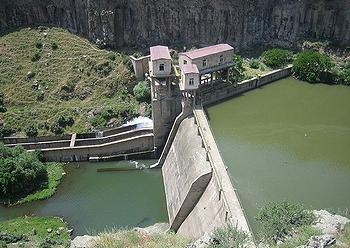
By Gayane Mkrtchyan
YEREVAN, Armenia, December 19, 2013 (ENS) – Environmentalists in Armenia say a strategy of building multiple hydroelectric stations to harness the country’s rivers is storing up problems for the future.
Armenia lacks oil and gas reserves and is trying to develop hydroelectric power as a way of reducing its reliance on fuel imports. Ecologists, however, say that damming up rivers destroys waterways and the unique ecosystems they support.
In one recent case of direct action, environmental activists joined residents of the village of Marts in the northern Lori region on November 17 to protest against plans to build a third power station on a river there. They blocked a major highway, causing traffic chaos, but left before police could arrive to disperse them.

“Rivers are being turned into pipelines,” said Levon Galstyan of the All-Armenian Ecological Front. “No public consultations were organised in the village [Marts], and people’s interests have been ignored.”
Liparit Simonyan, director of Martz Energy, the company in charge of the dam project, said its activities were entirely within the law.
“There’s a sense that it isn’t the locals protesting, but a group of activists representing some outside forces. They are spreading false information and setting people against one another other,” Simonyan told reporters.
“We are spending money; we are creating jobs,” he added.
Robert Galstyan, the village head in Marts, confirmed that the company was going to employ seven locals and had promised to provide the village with street lighting and a mains gas supply.
Karen Harutiunyan, an activist from the environmentalist group 100 Point, said claims of public consultation were untrue since the majority of local residents were clearly against the scheme.
In a separate development, villagers in the western Aragatsotn region turned out to protest against work on a fourth power station on the river Amberd.
Local resident Sasun Hayrapetyan said that villagers in the area would lose their water supplies.
“This hydropower station is being built next to us without any consultation,” she said.
Armenia has gone from having just 11 small hydroelectric power plants in 1997 to 137 small hydro power plants today, with another 77 being built. It also has bigger plants arranged in series of two, or “cascades,” Sevan-Hrazdan and Vorotan.
The construction drive is underpinned by a 2004 law which assumes that dams on mountain rivers could meet around 30 percent of Armenia’s electricity needs.

That is still some distance away. As Aram Gabrielyan, head of electricity supplies at the energy ministry, points out, nuclear power provided 28 percent of the country’s power last year, 42 percent was generated by gas-fired stations, and most of the rest by hydroelectric plants.
Galstyan said the government’s strategy is all wrong.
“Construction of hydroelectric power stations has reached such a level that in 20 or 30 years’ time, this state will be facing a social and ecological catastrophe,” he said. “There will be power stations on 90 percent of rivers, and in the dry season they will all dry up.”
Inga Zarafyan of Ecolur agrees that the threat was real, warning that “the number of sick rivers is constantly rising.”
“Twelve power stations have been built on the river Yeghegis, another nine are to be built on the Meghri river, and six more on the Getik and Marts, and also on rivers that feed Lake Sevan,” she said.
“The biggest is being built on the Argichi, with nine kilometres of pipes and four ten-megawatt turbines,” said Zarafyan. “We are scared to imagine what will be left of that river.”
Inessa Gabayan, national coordinator of an Armenian-Norwegian project to develop small hydroelectric power plants, urged local residents to contribute constructively rather than just objecting to them.
“The aim of our project is to identify problems and secure stable development in this sector,” she explained. “I believe new technologies can resolve the problems.”
{Gayane Mkrtchyan is a reporter with Armenianow.com. This article was originally published on December 17, 2013 by the Institute for War and Peace Reporting, www.iwpr.net.}
© 2013, Environment News Service. All rights reserved. Content may be quoted only with proper attribution and a direct link to the original article. Full reproduction is prohibited.
